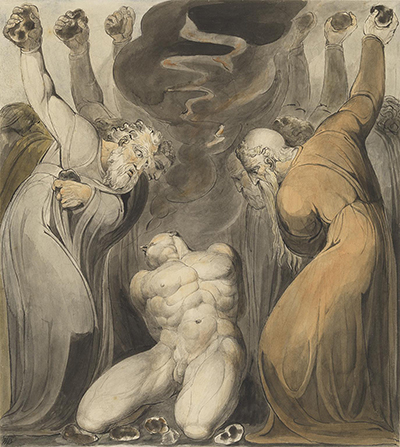William Blake has always had a special artistic language. The radical, rebellious symbolism from his books and humanist veins tap into a person's unbound scrimmage of pain and pleasure. He can express good and evil through visual poems. This article aims to look at his painting, The Blasphemer, process the colour, form, movement, and probably feel the spirit.
Summary of The Blasphemer by William Blake (1757-1827)
The picture is a visual illustration of the Old Testament lines from Leviticus 24:13-23. In the picture, the son of an Israelite woman is being stoned because of blasphemy against God. The Lord had informed Moses that "any person who blasphemes God's name…will be certainly be put to death and the whole congregation will surely stone him: and the stranger, who is born in the land, when he blasphemes the name of the Lord, will be put to death". This powerful watercolour is part of the series of 135 biblical-based paintings and drawings by Blake, commissioned by Thomas Butts, Blake's most loyal patron.
Interpretation of The Blasphemer
The piece of art is an illustration of Leviticus 24:23. The old matt, which has been replaced, had an engraving in the copperplate hand which gives the title, The Blasphemer. Also, there is a text from Leviticus that explains the story which starts from verse 10 to verse 16 entailing the condemnation to death by Moses of the son of the Israelite woman for blaspheming God's name.
The lurid wreath of smoke that is above the son's head together with the fire is quite a peculiar detail. The writhing, sensuous curves of the body in a lyrical movement portray the themes of morality, childhood, social justice, and suffering. For instance, the use of flames in the painting is to enhance the symbolism of what is deemed to be a condemnation of the Law of Moses that says, "An eye for an eye, a tooth for a tooth". Actually, this law was dictated by God to Moses because of the Blasphemer's offence.
From the image, the High Priests are the ones stoning the Prophet. The Israelite woman's son seems to be suffering disembowelment with an accompanying text that says, "an attack on vengeance". Their uplifted arms possess all the rich appeal and imaginative suggestiveness to the creative characteristic of William Blake. There is startling interweaving and asymmetry of the forms that Blake uses to give the illusion of a breathless cloud that is suffused with spiritual ecstasy and sex that imbibes the realm of the imagination and the sublime.




